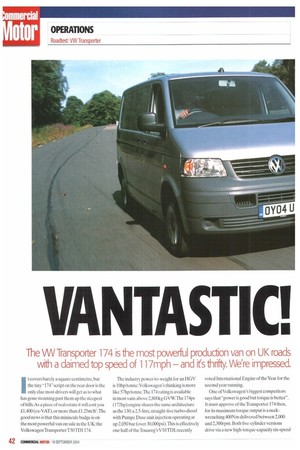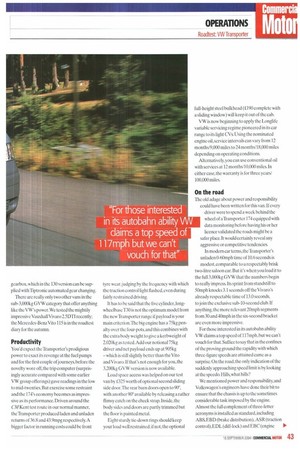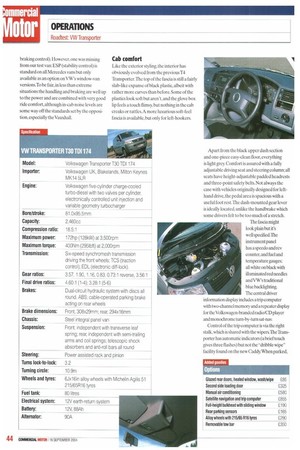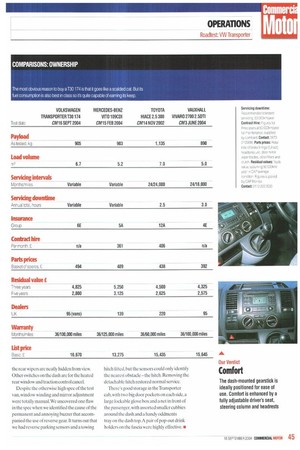IfliNTAST
Page 44

Page 45

Page 46

Page 47

If you've noticed an error in this article please click here to report it so we can fix it.
The \AN Transporter 174 is the most powerful production van on UK roads with a claimed top speed of 117mph — and it's thirty. We're impressed.
It covers barely a square centimetre, but the tiny "174" script on the rear door is the only clue most drivers will get as to what has gone steaming past them up the steepest of hills As a piece of real estate it will cost you £1,400 (ex-VAT),or more than £1.25m/ft=.The good news is that this miniscule badge is on the most powerful van on sale in the UK: the VolkswagenTransporter T30 TDI 174. The industry power-to-weight for an HGV is 10hpitonne:Volkswagen's thinking is more like 57hp/tonne. The 174 rating is available in most vans above 2,800kg GVW.The 174ps (172hp) engine shares the same architecture as the 130: a 2.5-litre, straight-five turbo-diesel with Pumpe Duse unit injection operating at up 2,050 bar (over 30.000psi).This is effectively one half of the Touareg'sV10 TDI, recently voted International Engine of the Year for the second year running.
One of Volkswagen's biggest competitors says that "power is good but torque is better". It must approve of the Transporter 174 then, for its maximum torque output is a neckwrenching 400Nm delivered between 2,000 and 2,300rpm. Both five-cylinder versions drive via a new high-torque-capacity six-speed gearbox, which in the 130 version can be supplied with Tiptronic automated gear changing.
There are really only two other vans in the sub-3,000kg GVW category that offer anything like the VW's power. We tested the mightily impressive Vauxhall Vivaro 2.5DTI recently; the Mercedes-Benz Vito 115 is in the roadtest diary for the autumn.
Productivity You'd expect the Transporter's prodigious power to exact its revenge at the fuel pumps and for the first couple of journeys, before the novelty wore off, the trip computer (surprisingly accurate compared with some earlier VW group offerings) gave readings in the low to mid-twenties. But exercise some restraint and the 174's economy becomes as impressive as its performance. Driven around the CM Kent test route in our normal manner, the Transporter produced laden and unladen returns of 36_8 and 43.9mpg respectively. A bigger factor in running costs could be front tyre wear, judging by the frequency with which the traction control light flashed, even during fairly restrained driving.
It has to be said that the five cylinder, longwheelbase T30 is not the optimum model from the new Transporter range if payload is your main criterion.The big engine has a 75kg penalty over the four-pots, and this combines with the extra body weight to give a kerbweight of 2,020kg as tested. Add our notional 75kg driver and net payload ends up at 905kg — which is still slightly better than the Vito and Vivaro. If that's not enough for you, the 3200kg G VW version is now available.
Load space access was helped on our test van by £325 worth of optional second sliding side door.The rear barn doors open to 90°, with another 900 available by releasing a rather flimsy catch on the check strap. Inside, the body sides and doors are partly trimmed but the floor is painted metal.
Eight sturdy tie-down rings should keep your load well restrained; if not, the optional full-height steel bulkhead (£190 complete with a sliding window) will keep it out of the cab.
VW is now beginning to apply the Longlife variable servicing regime pioneered in its car range to its light CVs. Using the nominated engine oil, service intervals can vary from 12 months/9,000 miles to 24 months/18,000 miles depending on operating conditions.
Alternatively, you can use conventional oil with services at 12 months/10,000 miles. In either case, the warranty is for three years/ 100,000 miles.
On the road
The old adage about power and responsibility could have been written for this van. If every driver were to spend a week behind the wheel of a Transporter 174 equipped with data monitoring before having his or her licence validated the roads might be a safer place. It would certainly reveal any aggressive or competitive tendencies.
In modern car terms, the Transporter's unladen 0-60mph time of 10.6 seconds is modest, comparable to a respectably brisk two-litre saloon car. But it's when you load it to the full 3,000kg GVW that the numbers begin to really impress. Its sprint from standstill to 50mph knocks 3.1 seconds off the Vivaro's already respectable time of 13.0 seconds, to join the exclusive sub-10-second club. If anything,the more relevant 20mph segments from 30 and 40mph in the six-second bracket are even more impressive.
For those interested in its autobahn ability VW claims a top speed of 117mph,but we can't vouch for that. Suffice to say that in the confines of the proving ground the rapidity with which three-figure speeds are attained came as a surprise. On the road, the only indication of the suddenly approaching speed limit is by looking at the speedo. Hills, what hills?
We mentioned power and responsibility,and Volkswagen's engineers have done their bit to ensure that the chassis is up to the sometimes considerable task imposed by the engine. Almost the full complement of three-letter acronyms is installed as standard, including ABS, EBD (brake distribution), ASR (traction control), EDL (diff-lock) and EBC (engine 111. braking control). However,one was missing from our test van: ESP (stability control) is standard on all Mercedes vans but only available as an option on VW's window-van versions.To be fair, in less than extreme situations the handling and braking are well up to the power and are combined with very good ride comfort, although in-cab noise levels are some way off the standards set by the opposition, especially the Vauxhall.
Cab comfort
Like the exterior styling. the interior has obviously evolved from the previousT4 Transporter. The top of the fascia is still a fairly slab-like expanse of black plastic, albeit with rather more curves than before. Some of the plastics look soft but aren't, and the glove box lip feels a touch flimsy, but nothing in the cab creaks or rattles. A more luxurious soft-feel fascia is available, but only for left-hookers. Apart from the black upper dash section and one-piece easy-clean floor, everything is light grey. Comfort is assured with a fully adjustable driving seat and steering column; all seats have height-adjustable padded headrests and three-point safety belts. Not always the case with vehicles originally designed for lefthand drive, the pedal area is spacious with a useful foot rest.The dash-mounted gear lever is ideally located, unlike the handbrake which some drivers felt to be too much of a stretch.
The fascia might look plain but it's well specified.The instrument panel has a speedo and rev counter, and fuel and temperature gauges; all white on black with illuminated red needles and VVV's traditional blue backlighting. The central driver information display includes a trip computer with two-channel memory and a repeater display for the Volkswagen-branded radio/CD player and monochrome turn-by-turn sat-nay.
Control of the trip computer is via the right static, which is shared with the wipers.The Transporter has automatic indicators (a brief touch gives three flashes) but not the "dribble wipe" facility found on the new Caddy. When parked, the rear wipers are neatly hidden from view. Other switches on the dash are for the heated rear window and traction control cancel.
Despite the otherwise high spec of the test van, window winding and mirror adjustment were totally rnanual.We uncovered one flaw in the spec when we identified the cause of the permanent and annoying buzzer that accompanied the use of reverse gear. It turns out that we had reverse parking sensors and a towing hitch lilted. but the sensors could only identify the nearest obstacle — the hitch. Removing the detachable hitch restored normal service.
There's good storage in the Transporter cab, with two big door pockets on each side, a large lockable glove box and a net in front of the passenger, with assorted smaller cubbies around the dash and a handy oddments tray on the dash top.A pair of pop-out drink holders on the fascia were highly effective. •






































































































































































































